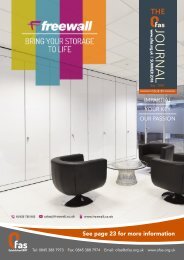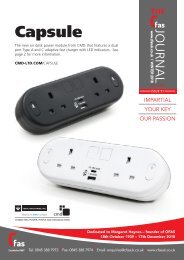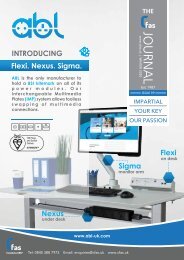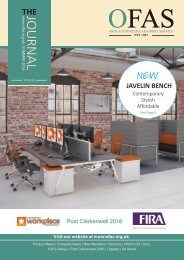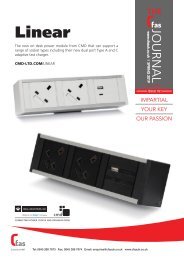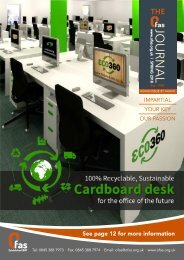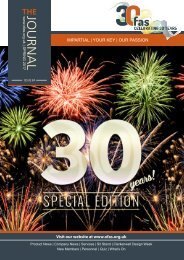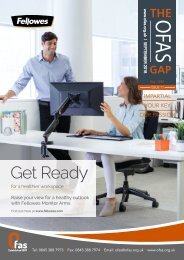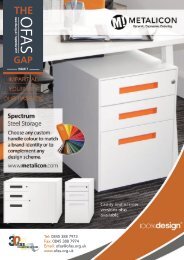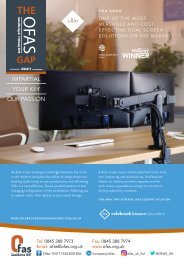Winter 2016
Winter 2016
Winter 2016
You also want an ePaper? Increase the reach of your titles
YUMPU automatically turns print PDFs into web optimized ePapers that Google loves.
Editorial<br />
Did you know that the upholstery fabrics we see and<br />
use in everyday office life have a purpose, not just for<br />
being colourful and attractive, but more importantly<br />
they need to perform and if maintained correctly, will<br />
last a long time?<br />
When fabrics are being designed,<br />
developed and manufactured, it is very<br />
important to follow a procedure, ensuring<br />
that whether they are produced using<br />
wool, polyester, nylon or any other fibres<br />
or mixes, that they meet the correct<br />
industry standards, for key areas such as<br />
abrasion, fire retardancy, light fastness<br />
and general strength, giving then expected<br />
durability.<br />
Abrasion is a key indicator for how a<br />
fabric will perform and this is measured<br />
by the Martindale Test, where the<br />
intended fabric is ‘rubbed’ against an<br />
industry identified worsted wool. One<br />
circular motion cycle on the machine (see<br />
image) indicates one rub and the British<br />
Standard sets the minimum at 40,000<br />
rubs for general contract environments.<br />
Fire Retardancy is measured for the<br />
environments that the seating units are<br />
intended. For general offices, schools<br />
and similar areas the standard of Low<br />
Hazard BS 7176 Cigarette and Match<br />
FR is the criteria to be met, however for<br />
more public areas where high volumes of<br />
traffic, offering a greater fire risk, such as<br />
restaurants, bars, hotels, hospitals and<br />
equivalent areas the standard known as<br />
Medium Hazard BS 7176 Crib 5 is the<br />
minimum requirement.<br />
8 No fading Outstanding<br />
7 Very slight fading Excellent<br />
6 Slight fading Very good<br />
5 Moderate fading Good<br />
4 Appreciable fading Moderate<br />
3 Significant fading Fair<br />
2 Extensive fading Poor<br />
1 Very extensive fading Very poor<br />
With every effort being made to ensure that the fabrics meet the standards, it is<br />
also the overall care and maintenance however that plays a major part in their life<br />
expectancy. Regular vacuuming of the seating is a must, to remove any day to day dust,<br />
dirt and soiling that can overtime become embedded into the fabric construction, thus<br />
resulting in degradation not just from a visual aspect but from a quality point of view.<br />
Post treatments to aid against spillages and heavy soiling can and are easily applied<br />
to most fabrics with resounding success, however simply mopping up any spillages<br />
promptly and regular vacuuming is the answer. After all, we clean and vacuum our<br />
carpets at home regularly to keep their appeal, why shouldn’t we do the same with the<br />
upholstery!<br />
Editorial kindly provided by Mr Mark Holliday - Bradbury Fabrics<br />
Fastness to light is an important criteria,<br />
where fabrics are exposed to excess<br />
daylight and subsequently fading could<br />
be caused. This is measured by exposure<br />
of the fabric to a Zenon lamp.<br />
The fabric is then assessed for fading using<br />
blue scales and is then graded between 0<br />
and 8, with a resultant grade between 5<br />
and 8 being the expected level that is<br />
deemed acceptable.<br />
www.ofas.org.uk<br />
WINTER <strong>2016</strong><br />
9



